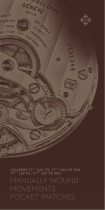La page est en cours de chargement...

English
Français
Deutsch

English

Reference 5959
Caliber CHR 27-525 PS
Ultra-thin manually wound wristwatch with
split-seconds chronograph.
The Ref. 5959 reaffirms Patek Philippe’s unmatched
virtuosity in the domain of complications: it is the
thinnest split-seconds column wheel chronograph
movement ever built. To achieve this record,
the experts at the Geneva workshops developed
a highly sophisticated chronograph caliber,
designed from the very start as an ultra-thin split-
seconds chronograph. It was a challenging venture
because the split-seconds mechanism is at least
as difficult a complication to master as a minute
repeater or a tourbillon. The result is the caliber
CHR 27-525 PS movement which unites Geneva’s
grand watchmaking heritage with 21st-century
technology.

Haute horlogerie at its very finest
Patek Philippe’s caliber CHR 27-525 PS is the world’s
thinnest split-seconds monopusher chronograph
movement with column wheel control: it is a scant
5.25 mm thick. Not least, this record was achieved
thanks to an unusual design approach for the conti-
nuously running 60-minute counter. This innova-
tion not only results in a slimmer silhouette, it also
offsets the torque differences between the running
and stopped states of the chronograph.
The three chronograph wheels (driving, clutch, and
seconds wheels) are another exclusive feature of
the CHR 27-525 PS movement. Their innovative and
patented toothing geometries reduce wear and op-
timize power transmission within the chronograph
mechanism.
The pinnacle of artisanship
The caliber CHR 27-525 PS movement is a clas-
sic split-seconds chronograph construction
with two column wheels that, as always at Patek
Philippe, are crowned by polished caps. The
bridges à l’ancienne are meticulously chamfered,
polished, and decorated with Geneva striping.
Each caliber is hand-crafted one by one by a master
watchmaker in the manufacture’s Haute Horlogerie
ateliers. Practically every component is individually
filed, chamfered, polished, adjusted, and finished.
Subsequently, the watchmaker performs a trial
assembly, the so-called repassage en blanc, to ve-
rify the functional integrity of the movement.
Afterwards, the caliber is completely disassem-
bled again. When all parts have been cleaned,
they are reassembled, lubricated, and fine-tuned.
This ancestral method produces horological mas-
terpieces that exceed the expectations of even
the most discerning aficionados.

Split-seconds button
Winding crown
Position 1: to wind the watch
Position 2: to set the time
Subsidiary seconds
Chronograph hand Chronograph button
60-minute counter
1 2
Split-seconds hand
Instructions
WINDING CROWN
The winding crown is used to wind the watch
(position 1) and to set the time (position 2)
MANUALLY WOUND
Your watch has a manually wound movement.
When fully wound, it has a power reserve of at
least 48 hours. We recommend that you wind
your watch each day at about the same time,
preferably in the morning (about 25 clockwise
turns of the crown).
Caution: Please wind the watch before you put it on. This
way, you can avoid lateral pressure on the winding stem
which in the course of the years could damage the stem
tube. Turn the crown gently and uniformly and stop as soon
as you feel resistance; if you wind the watch too vigorously,
this might damage the movement.
SETTING THE TIME
To set the time, pull the crown out, and turn it
in either direction. Once the correct time is set,
press the crown home again. The movement has a
stop-seconds mechanism (balance wheel blocker)
that allows the watch to be synchronized with
a time signal to an accuracy of one second. The
seconds hand stops when the winding crown is
pulled. It starts running again as soon as you push
the crown home again.
Caution: Please set the time only when the chronograph
is stopped and the chronograph and rattrapante hands both
return to zero, and preferably – to prevent lateral pressure
on the winding stem – before you put the watch on. We
recommend that you turn the crown only with two fingers
and use your fingernails to pull it out.

CHRONOGRAPH
The Patek Philippe rattrapante chronograph
allows you to measure the duration of events,
record lap times. These measurements are perfor-
med with the two large sweep stop hands – the
chronograph and rattrapante hands – and with
the small 60-minute counter at 3 o’clock. Unlike
most split seconds chronographs, the Ref. 5959
is a three-phase chronograph that requires only
two pushers.
Actuating the pusher in the winding crown se-
quentially activates the three following com-
mands:
1. Simultaneously start the chronograph and
rattrapante hands,
2. Simultaneously stop the chronograph and
rattrapante hands,
3. Reset the chronograph and rattrapante hands.
Note: To avoid chronograph start problems, we recom-
mend that you postpone the use of the chronograph for 2
minutes after having set the time.
The pusher at 2 o’clock controls only the rattrapante hand.
MEASURING DURATIONS AND STOPPING LAP TIMES
When the event to be timed begins, actuate the
pusher in the winding crown: The superposed
chronograph and rattrapante hands begin to run.
To measure a lap time, press the pusher at 2 o’clock:
The rattrapante hand will stop but the chronograph
hand keeps running. Now you can take a note of
the lap time. When you actuate the pusher at 2
o’clock again, the rattrapante hand will catch up
with the chronograph hand and both hands, now
superposed, will continue running. This function
can be activated as many times as you wish. To stop
the final time, actuate the pusher in the winding
crown: this will stop the chronograph hand and
you can take a note of the duration of the event.
When you actuate the pusher in the winding crown
again, the chronograph and rattrapante hands will
both return to zero.
Caution: To reset the chronograph and rattrapante hands
to zero at the same time, they must be superposed. If the rat-
trapante hand is still indicating a lap time, actuate the pusher
at 2 o’clock to make it catch up with the chronograph hand,
and then reset both hands to zero by actuating the pusher in
the winding crown.

CALIBER: CHR 27-525 PS, MANUALLY WOUND
DIAMETER: 27.30 MM
HEIGHT: 5.25 MM
NUMBER OF PARTS: 252
NUMBER OF JEWELS: 27
POWER RESERVE: WITH THE CHRONOGRAPH DISENGAGED:
48 HOURS MIN.
BALANCE: GYROMAX®
FREQUENCY: 21,600 SEMI-OSCILLATIONS PER HOUR (3 Hz)
BALANCE SPRING: BREGUET
HALLMARK: PATEK PHILIPPE SEAL
Movement technical data

Recommendations
WATER RESISTANCE
Although your watch is equipped with a water-re-
sistant crown, it is not protected at all against the
ingress of moisture because of the slot for the
minute repeater slide.
Therefore, exercise care to ensure that liquid does not come
into contact with your watch.
SERVICE
We recommend that you have your watch ser-
viced at least once every three to five years. For
this purpose, we suggest you take it to an Autho-
rized Patek Philippe Retailer who will send it to
our Geneva manufacture. You can then be assured
that your watch will be cared for by a qualified
master watchmaker at the Patek Philippe head-
quarters in Geneva.
The master watchmaker will disassemble the mo-
vement and then inspect, clean, and lubricate
all the individual parts prior to reassembly. The
watch will also be tested and the escapement
regulated if necessary. Finally, its performance
and rate accuracy will be monitored for a period
of two weeks.
The entire process may take several weeks
because each watch must undergo a complete
series of tests to fulfill the strict quality criteria
of Patek Philippe.
If you have any questions regarding service issues, please
contact your nearest Authorized Patek Philippe Retailer or
our International Customer Service Department in Geneva.
You may also visit www.patek.com.
PATEK PHILIPPE SEAL
The Patek Philippe Seal is a global emblem of qua-
lity that applies to the completed and fully cased
watch. It covers the movement, the case, the dial,
the hands, the pushers, the straps and bracelets,
the clasps, as well as all other components that
contribute to the accuracy and aesthetic appeal
of a watch. It takes technical, functional, and
design-related aspects into account and also
covers the visual appearance of the watch, its
rate accuracy and dependability, as well as the
quality of the customer service to which its owner
is entitled. It encompasses the entire know-how
and the unique facets that govern the develop-
ment, production, and long-term maintenance of
an exceptional timepiece.

Français

Référence 5959
Calibre CHR 27-525 PS
Montre-bracelet extra-plate
avec chronographe à rattrapante
et remontage manuel.
Avec la Référence 5959, Patek Philippe réaffirme
sa maîtrise souveraine des complications en
présentant le mouvement de chronographe à
rattrapante à roues à colonnes le plus plat jamais
réalisé. Pour relever ce défi, la manufacture
genevoise a développé un calibre de base
chronographe très sophistiqué, conçu dès
l’origine en tant que chronographe à rattrapante
extra plat. Un exploit de taille, car le mécanisme
de rattrapante passe pour une complication aussi
difficile à réaliser qu’une répétition minutes ou un
tourbillon. Ainsi est né le Calibre CHR 27‑525 PS,
alliance parfaite entre grand art horloger genevois
et technologie du XXIe siècle.

Un chef-d’œuvre de haute horlogerie
Avec le calibre CHR 27‑525 PS, Patek Philippe
a créé le mouvement chronographe mono‑
poussoir à rattrapante et roues à colonnes le plus plat
jamais réalisé: 5,25 mm d’épaisseur. Cette prouesse
s’explique notamment par la construction
particulière du compteur 60 minutes «traînant»
(tournant en continu), une innovation qui permet
de faire d’une pierre deux coups en réduisant la
hauteur du mouvement, tout en disposant d’un
système de compensation des différences de
couples entre chronographe enclenché et ar‑
rêté. Autre exclusivité introduite sur le calibre
CHR 27‑525 PS: les trois roues du mécanisme de
chronographe (roue entraîneuse de chronographe,
roue d’embrayage et roue intermédiaire) présen‑
tent des profils de dents brevetés permettant de
réduire l’usure tout en optimisant le fonctionne‑
ment du chronographe.
Un fleuron d’artisanat
Le calibre CHR 27‑525 PS présente une construc‑
tion de chronographe classique avec deux roues
à colonnes dotées, comme toujours chez Patek
Philippe, de chapeaux polis. Les ponts à l’ancienne
sont soigneusement anglés, polis et ornés d’un
décor de Côtes de Genève. Chaque calibre est
fabriqué à l’unité entre les mains d’un maître
horloger au sein des ateliers de «Haute Hor‑
logerie». Tous les composants sont un à un li‑
més, anglés, polis, ajustés et terminés. Les horlo‑
gers effectuent ensuite un assemblage test appelé
«repassage en blanc» afin de contrôler toutes
les fonctions, puis l’ensemble est à nou‑
veau entièrement démonté, nettoyé, réas‑
semblé, lubrifié et réglé. Ces méthodes de
fabrication à l’ancienne donnent naissance à des
chefs‑d’œuvre dépassant toutes les attentes des
connaisseurs les plus exigeants.

Poussoir de rattrapante
Couronne de remontoir
Position 1: remontage
Position 2: mise à l’heure
Petite seconde
Aiguille de chronographe Poussoir de chronographe
Compteur 60 minutes
1 2
Aiguille de rattrapante
Mode d’emploi
COURONNE DE REMONTOIR
Le remontage (position 1) et la mise à l’heure
(position 2) s’effectuent à l’aide de la couronne
de remontoir.
REMONTAGE
Votre montre est dotée d’un mouvement à re‑
montage manuel. Complètement remontée, elle
bénéficie d’une réserve de marche de minimum
48 heures. Nous vous recommandons de la
remonter tous les jours plus ou moins à la
même heure, de préférence le matin (environ
25 tours de couronne, dans le sens des aiguilles
d’une montre).
Attention: il est préférable d’effectuer ce remontage
hors du poignet pour éviter les pressions latérales qui, au fil
des ans, risqueraient d’endommager le tube de la couronne
de remontoir. Tournez la couronne doucement et réguliè-
rement, en arrêtant dès que vous sentez une résistance; un
remontage trop énergique peut endommager le mouvement
MISE À L’HEURE
L’heure se règle en tirant doucement la couronne
et en déplaçant les aiguilles vers l’avant ou vers
l’arrière. Lorsque les aiguilles indiquent la bonne
heure, poussez la couronne dans sa position ini‑
tiale (contre le boîtier). Le mouvement comporte
un système de «stop seconde» (arrêt du balancier)
qui vous permet de faire une mise à l’heure à la
seconde près. Lorsque vous tirez sur la tige de
remontoir, l’aiguille des secondes s’arrête instan‑
tanément. Elle redémarre immédiatement lorsque
vous repoussez la couronne contre le boîtier après
avoir fait la mise à l’heure.
Attention: la mise à l’heure doit être effectuée exclusive-
ment avec le chronographe arrêté, et de préférence hors du
poignet, afin d’éviter les pressions latérales sur le tube de la
couronne. Nous vous recommandons de n’utiliser que deux
doigts et de faire levier avec l’ongle pour tirer la couronne.

CHRONOGRAPHE
Le chronographe à rattrapante Patek Philippe
vous permet de chronométrer des événements,
de mesurer des temps intermédiaires. Il possède
pour cela deux grandes aiguilles des secondes au
centre du cadran – l’aiguille de chronographe et
l’aiguille de rattrapante – ainsi qu’une aiguille des
minutes sur un petit compteur 60 minutes à 3h.
Contrairement à la plupart des chronographes à
rattrapante, la référence 5959 Patek Philippe est
ce qu’on appelle un «chronographe trois temps»,
qui ne nécessite que deux poussoirs.
En appuyant sur le poussoir logé dans la couronne,
on active successivement les trois fonctions sui‑
vantes:
1. démarrage simultané des aiguilles de chrono‑
graphe et de rattrapante,
2. arrêt simultané des aiguilles de chronographe
et de rattrapante,
3. remise à zéro des aiguilles de chronographe
et de rattrapante.
Attention : pour éviter tout problème de démarrage
du chronographe, il est recommandé d’attendre 2 minutes
après une mise à l’heure avant d’enclencher le chrono-
graphe.
Le poussoir à 2h sert exclusivement aux commandes de
l’aiguille de rattrapante.
MESURE D’UN TEMPS INTERMÉDIAIRE
Pour lancer le chronométrage, pressez sur le
poussoir logé dans la couronne: l’aiguille de chro‑
nographe et l’aiguille de rattrapante, superposées,
se mettent en marche. Pour mesurer un temps
intermédiaire, pressez sur le poussoir à 2h: l’ai‑
guille de rattrapante s’immobilise, tandis que l’ai‑
guille de chronographe poursuit sa course. Vous
pouvez maintenant lire le temps intermédiaire.
Si vous pressez à nouveau sur le poussoir à 2h,
l’aiguille de rattrapante rejoint instantanément
l’aiguille de chronographe et les deux aiguilles
poursuivent leur course en parfaite synchronisa‑
tion. Vous pouvez répéter ce processus aussi sou‑
vent que vous le désirez. Pour mesurer le temps
final, actionnez le poussoir logé dans la couronne:
l’aiguille de chronographe s’arrête et vous pouvez
lire le temps mesuré. Une nouvelle pression sur
le poussoir logé dans la couronne vous permettra
de remettre à zéro les deux aiguilles de chrono‑
graphe et de rattrapante.
Attention: pour pouvoir être remises à zéro ensemble,
les aiguilles de chronographe et de rattrapante doivent être
superposées. Si l’aiguille de rattrapante est encore arrêtée
sur un temps intermédiaire, commencez par lui faire «rat-
traper» l’aiguille de chronographe grâce au poussoir à 2h,
avant de remettre à zéro les deux aiguilles à l’aide du poussoir
logé dans la couronne.

CALIBRE: CHR 27-525 PS, REMONTAGE MANUEL
DIAMÈTRE: 27,30 MM
ÉPAISSEUR: 5,25 MM
NOMBRE DE COMPOSANTS: 252
NOMBRE DE RUBIS: 27
RÉSERVE DE MARCHE: AVEC LE CHRONOGRAPHE NON ENCLENCHÉ :
48 HEURES MIN.
BALANCIER: GYROMAX ®
FRÉQUENCE: 21 600 ALTERNANCES PAR HEURE (3 Hz)
SPIRAL: BREGUET
SIGNE DISTINCTIF: POINÇON PATEK PHILIPPE
Caractéristiques techniques du mouvement

Recommandations
ETANCHÉITÉ
Même si votre montre est équipée d’une couronne
étanche, le mécanisme du verrou de sonnerie ne
permet aucune protection contre l’humidité.
Veillez donc à ce qu’aucun liquide n’entre en contact avec
votre montre.
ENTRETIEN
Nous vous recommandons de faire réviser votre
montre au moins une fois tous les trois à cinq ans.
Nous vous suggérons pour cela de la remettre à un
agent agréé Patek Philippe qui se chargera de l’en‑
voyer à la manufacture. Vous serez ainsi assuré
que votre montre sera contrôlée par un maître
horloger qualifié chez Patek Philippe, à Genève.
Le maître horloger démontera complètement le
mouvement, nettoiera tous ses composants, le
vérifiera puis réassemblera le mécanisme en
lubrifiant les pièces qui l’exigent. Après avoir testé
le bon fonctionnement de la montre et procédé,
si nécessaire, au réglage de l’échappement, il
gardera la montre au moins deux semaines sup‑
plémentaires afin d’en régler la marche.
L’ensemble du service peut prendre plusieurs
semaines, car il dépend de la procédure de tests
complète établie pour répondre aux normes de
qualité Patek Philippe.
Pour toute question concernant l’entretien de votre montre,
vous pouvez prendre contact avec nos distributeurs, nos
concessionnaires agréés ou à notre Service Clients Interna-
tional à Genève; vous pouvez également consulter notre site
Internet www.patek.com.
POINÇON PATEK PHILIPPE
Label de qualité globale, le Poinçon Patek Phi‑
lippe s’applique à l’ensemble de la montre finie,
en englobant à la fois le mouvement, le boîtier,
le cadran, les aiguilles, les poussoirs, les bracelets,
les fermoirs, ainsi que tous les autres éléments
concourant à la bonne marche ou à l’esthétique
d’un garde‑temps. Couvrant à la fois les aspects
techniques, fonctionnels et esthétiques, il ne
met pas seulement en valeur la bienfacture de la
montre, mais aussi sa précision, sa fiabilité, ainsi
que la qualité du service. Il intègre par là même
tous les savoir‑faire et signes distinctifs liés à la
conception, à la fabrication et à l’entretien à long
terme d’un garde‑temps d’exception.

Deutsch

Referenz 5959
Kaliber CHR 27-525 PS
Extraflache Armbanduhr
mit Eindrücker-Doppelchronograph
und Handaufzug.
Mit der Referenz 5959 liefert Patek Philippe einen
weiteren Beweis Ihrer Virtuosität auf dem Gebiet der
uhrmacherischen Komplikationen und präsentiert
das flachste je gebaute Doppelchronographenwerk
mit Schaltrad-Mechanik. Zu diesem Zweck
wurde ein äußerst kunstvolles Basis-kaliber
entwickelt, das von Anfang an als extraflaches
Doppelchronographenwerk ausgelegt war. Eine
große Herausforderung, gilt doch die mechanische
Umsetzung der Doppelchronographenfunktion
als Schwierigkeitsgrad, der durchaus mit der
Herstellung einer Minutenrepetition oder eines
Tourbillons vergleichbar ist. Entstanden ist
das Kaliber CHR 27-525 PS, das für die perfekte
Verbindung der großen Genfer Uhrmacherkunst
mit der Technologie des 21. Jahrhunderts steht.

Ein Meisterwerk hoher Uhrmacherkunst
Mit dem Kaliber CHR 27-525 PS hat Patek Philippe
das weltweit flachste Eindrücker-Doppelchronogra-
phenwerk mit Schaltradsteuerung geschaffen. Seine
Höhe: 5,25 mm. Möglich wurde diese Meisterleis-
tung nicht zuletzt durch die raffinierte Konstruktion
des mitlaufenden (kontinuierlich drehenden)
60-Minutenzählers. Seine innovative Auslegung
ermöglicht eine flachere Bauweise und kompensiert
gleichzeitig die Drehmomentunterschiede bei
ein- und ausgeschalteter Chronographenfunktion.
Eine weitere Exklusivität des Kalibers CHR 27-525 PS
sind die drei Chronographenräder (Chrono-Zent-
rumsrad, Kupplungsrad und Mitnehmerrad). Ihre
neuartigen patentierten Zahnprofile reduzieren die
Abnützung und optimieren die Kraftübertragung
innerhalb des Chronographenmechanismus.
Eine handwerkliche Meisterleistung
Beim Kaliber CHR 27-525 PS handelt es sich um eine
klassische Doppelchronographen-Konstruktion
mit zwei Schalträdern, die wie immer bei Patek
Philippe polierte Hütchen tragen. Die Brücken
„à l’ancienne“ sind sorgfältig mit polierten
Anglierungen und mit Genfer Streifen versehen.
Jedes Kaliber entsteht als Einzelanfertigung
unter den Händen eines Meisteruhrmachers
in den „Haute Horlogerie“-Ateliers. Jedes
Bestandteil wird einzeln zurechtgefeilt, angliert,
poliert, eingepasst und fertig gestellt. Jetzt
nimmt der Uhrmacher eine Testmontage, die
so genannten „repassage en blanc“ vor, um jede
Funktion genau zu kontrollieren. Dann wird das
ganze Uhrwerk wieder demontiert, gereinigt
und anschließend neu zusammengesetzt, geölt
und einreguliert. Auf diese althergebrachte
Fabrikationsweise entstehen kleine Meisterwerke,
die selbst die höchsten Ansprüche ausgewiesener
Kenner übertreffen.

Drücker für den Einholzeiger
Aufzugskrone
Position 1: Aufziehen
Position 2: Zeigerstellen
Kleine Sekunde
Chronographenzeiger Chronographendrücker
60-Minuten-Zähler
1 2
Einholzeiger
Bedienungsanleitung
AUFZUGSKRONE
Das Aufziehen (Position 1) und Zeigerstellen (Po-
sition 2) erfolgt mit Hilfe der Aufzugskrone.
HANDAUFZUG
Ihre Uhr besitzt ein Uhrwerk mit Handaufzug.
Komplett aufgezogen hat sie eine Gangreserve von
mindestens 48 Stunden. Wir empfehlen Ihnen,
Ihre Uhr jeden Tag in etwa zur gleichen Zeit
aufzuziehen, mit Vorteil morgens (ca. 25 Um-
drehungen der Krone im Uhrzeigersinn).
Achtung: Ziehen Sie die Uhr auf, bevor Sie diese anlegen.
Sie vermeiden dadurch seitlichen Druck auf die Aufzugs-
welle, der im Lauf der Jahre das Aufzugsrohr in Mitleiden-
schaft ziehen könnte. Drehen Sie die Aufzugskrone sanft und
regelmäßig und hören Sie auf, sobald Sie einen Widerstand
fühlen; ein zu heftiges Aufziehen kann das Uhrwerk beschä-
digen.
EINSTELLEN DER UHRZEIT
Um die Zeiger auf die richtige Uhrzeit zu stellen,
ziehen Sie sanft die Aufzugskrone und drehen
diese vor- oder rückwärts. Sind die Zeiger auf die
richtige Uhrzeit gestellt, drücken Sie die Krone
wieder ans Gehäuse. Das Werk verfügt über einen
Sekundenstopp (Anhalten der Unruh), dank dem
die Uhrzeit mit Hilfe eines Zeitzeichens sekun-
dengenau eingestellt werden kann. Durch Zie-
hen der Aufzugskrone wird der Sekundenzeiger
gestoppt. Er setzt sich unverzüglich wieder in
Bewegung, sobald Sie nach dem Stellen der Zeiger
die Krone ans Gehäuse drücken.
Achtung: : Das Einstellen der Uhrzeit darf nur bei ge-
stopptem Chronographen erfolgen, und mit der Chronogra-
phen- und der Einholzeiger wieder auf Null gestellt und mit
Vorteil, bevor Sie die Uhr anlegen. Sie vermeiden dadurch
seitlichen Druck auf die Aufzugswelle. Wir empfehlen, die
Krone nur mit zwei Fingern zu bedienen und zum Ziehen
der Krone die Fingernägel als Hebel zu benützen.

CHRONOGRAPH
Mit dem Patek Philippe Doppelchronographen
können Sie die Dauer von Ereignissen stoppen,
Zwischenzeiten nehmen. Dazu dienen die beiden
großen Stoppzeiger aus der Mitte – der Chrono-
graphen- und der Einholzeiger – sowie der Minu-
tenzeiger im kleinen 60-Minutenzähler bei 3 Uhr.
Anders als die meisten Doppelchronographen ist
die Ref. 5959 ein Drei-Phasen-Chronograph, der
nur zwei Drücker benötigt.
Durch Betätigen des Drückers in der Aufzugs-
krone werden nacheinander die drei folgenden
Kommandos ausgelöst werden:
1. Gleichzeitiges Starten des Chronographen-
und Einholzeigers,
2. Gleichzeitiges Stoppen des Chronographen-
und Einholzeigers,
3. Nullstellen des Chronographen- und des Ein-
holzeigers.
Achtung: Um etwaige Probleme mit dem Starten des Chro-
nographen zu vermeiden, sollten Sie nach dem Einstellen der
Uhrzeit jeweils 2 Minuten warten, bevor Sie den Chronographen
auslösen.
Der Drücker bei 2 Uhr steuert ausschließlich den Einholzeiger.
ZEITMESSUNG MIT ZWISCHENZEITNAHME
Betätigen Sie bei Beginn des zu messenden
Ereignisses den Drücker in der Aufzugskrone: Der
Chronographen und der Einholzeiger setzen sich
übereinander liegend in Bewegung.
Um eine Zwischenzeit zu messen, betätigen Sie den
Drücker bei 2 Uhr: Der Einholzeiger bleibt stehen,
während der Chronographenzeiger weiterläuft.
Jetzt können Sie die Zwischenzeit ablesen. Sobald
Sie den Drücker bei 2 Uhr erneut betätigen,
holt der Einholzeiger den Chronographenzeiger
wieder ein, und beide Zeiger laufen deckungsgleich
weiter. Diesen Vorgang können Sie beliebig oft
wiederholen. Um die Endzeit zu stoppen, betätigen
Sie den Drücker in der Aufzugskrone: der Chrono-
graphenzeiger hält an, und Sie können die Endzeit
ablesen. Durch erneutes Betätigen des Drückers in
der Aufzugskrone werden der Chronographen- und
der Einholzeiger wieder auf Null gestellt.
Achtung: Um den Chronographen- und den Einholzeiger
miteinander auf Null zu stellen, müssen beide Zeiger de-
ckungsgleich übereinander liegen. Steht der Einholzeiger noch
auf einer Zwischenzeit, lassen Sie ihn durch Betätigen des
Drückers bei 2 Uhr zum Chronographenzeiger vorspringen
und stellen dann beide Zeiger mit dem Drücker in der
Aufzugskrone auf Null.
/









